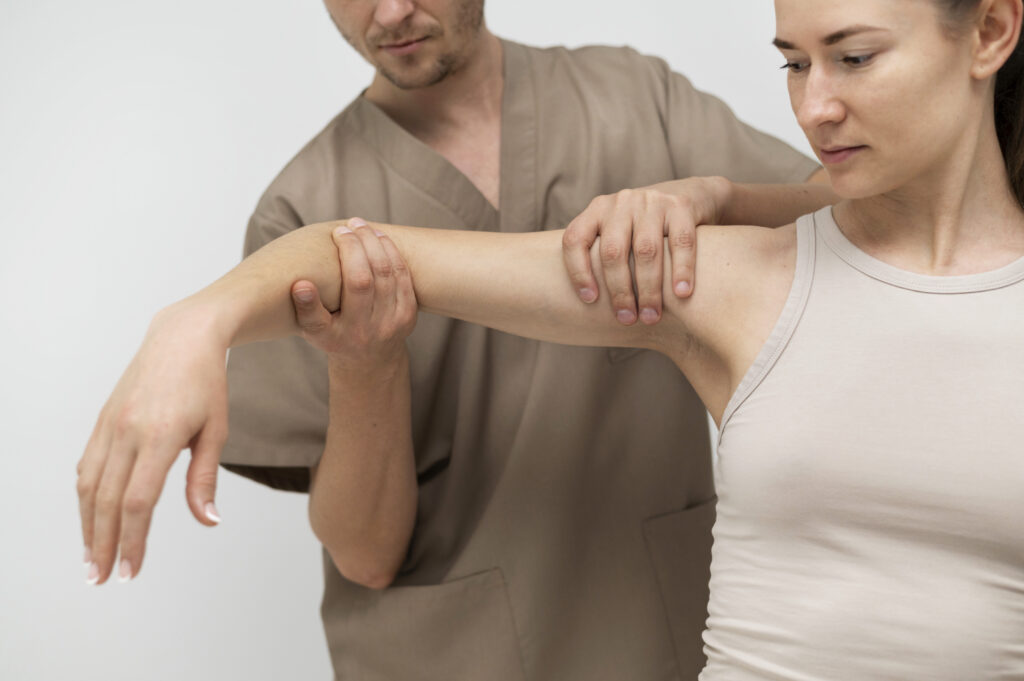If you're living with arthritis pain, you might often feel overwhelmed by the constant discomfort and limitations it brings. You may not realize, however, that gentle relief is achievable through mindful practices and low-impact exercises that cater to your unique needs. Exploring techniques like yoga or swimming can enhance your flexibility while fostering emotional balance. But what if there's more to this journey than just physical activity? There are holistic approaches that could transform your experience and improve your quality of life in unexpected ways.
Understanding Arthritis Pain
Arthritis pain affects millions of people worldwide, making everyday tasks a struggle. You might experience stiffness, swelling, or tenderness in your joints, which can limit your range of motion and affect your quality of life. Understanding the nature of arthritis pain is vital to managing it effectively.
Arthritis primarily comes in two forms: osteoarthritis and rheumatoid arthritis. Osteoarthritis often results from wear and tear on the joints over time, while rheumatoid arthritis is an autoimmune condition that leads to inflammation in the joints. Both types can bring about persistent discomfort that disrupts your daily activities.
You may notice that certain factors exacerbate your pain, such as changes in weather, stress, or even your diet. Being mindful of these triggers can help you anticipate flare-ups and take preventive measures. For instance, you might find that cold, damp days make your joints feel stiffer, prompting you to dress warmly and stay active indoors.
Moreover, arthritis pain isn't solely physical; it can take an emotional toll as well. You might feel frustrated or overwhelmed by the limitations it imposes, which can lead to anxiety or depression. Acknowledging these feelings is essential.
You're not alone in this journey, and finding support through friends, family, or support groups can make a significant difference.
Gentle Exercise Techniques
Finding relief from arthritis pain often involves incorporating gentle exercise techniques into your routine. Engaging in low-impact activities can help maintain joint function, improve flexibility, and reduce stiffness.
It's important to choose exercises that suit your comfort level while gradually increasing intensity as your strength improves.
Here are some gentle exercise techniques you might consider:
- Walking: A simple, low-impact exercise that can be done almost anywhere. Start with short distances and gradually increase your pace and duration.
- Swimming: The buoyancy of water reduces strain on your joints while providing resistance for muscle strengthening. Try water aerobics or simply swimming at a comfortable pace.
- Yoga: This practice focuses on gentle stretching and breathing techniques, promoting relaxation and enhancing flexibility. Look for classes specifically designed for arthritis sufferers.
- Tai Chi: This ancient martial art combines slow, controlled movements with deep breathing. It can improve balance, coordination, and overall joint mobility.
Before starting any exercise program, it's wise to consult with your healthcare provider to confirm your chosen activities are safe for your condition.
Incorporating these gentle techniques into your routine can lead to significant improvements in your overall well-being. Stick with it, listen to your body, and you may just find that moving more helps alleviate some of the pain associated with arthritis.
Dietary Modifications for Relief
Making dietary modifications can play an important role in managing arthritis pain. By focusing on the right foods, you can help reduce inflammation and improve your overall well-being. Start by incorporating more fruits and vegetables into your meals. These foods are rich in antioxidants, vitamins, and minerals that support your immune system and combat inflammation.
Leafy greens like spinach and kale, as well as colorful options like berries and sweet potatoes, should be your go-to choices.
Next, consider adding healthy fats to your diet. Omega-3 fatty acids, found in fatty fish like salmon and mackerel, have anti-inflammatory properties that can help ease joint pain. If you're not a fan of fish, you can opt for flaxseeds, chia seeds, or walnuts as alternative sources.
Limiting processed foods and sugar is also essential. These items often contribute to inflammation and can exacerbate your symptoms. Instead, choose whole grains like brown rice and quinoa, which provide sustained energy and essential nutrients.
Don't forget about hydration. Drinking plenty of water throughout the day can help maintain joint lubrication. Herbal teas, especially those with anti-inflammatory properties like ginger or turmeric, can also be beneficial.
Lastly, keep a food diary to track which foods may trigger your symptoms. By being mindful of what you eat, you can create a personalized dietary plan that leads to relief.
Embracing these dietary changes can notably improve your quality of life while managing arthritis pain.
Mindfulness and Relaxation Practices
Mindfulness and relaxation practices can be powerful tools in managing arthritis pain.
By incorporating breathing techniques, guided imagery sessions, and progressive muscle relaxation into your routine, you can find relief from discomfort and stress.
Let's explore how these methods can help you feel more at ease.
Breathing Techniques Benefits
Breathing techniques offer a powerful way to manage arthritis pain while enhancing your overall sense of well-being. By focusing on your breath, you can create a calming effect that helps reduce stress and tension in your body. This can lead to decreased pain perception and increased emotional resilience.
Here are some benefits you can experience through breathing techniques:
- Pain Reduction: Deep, mindful breathing can lower the intensity of pain signals your body sends to your brain.
- Increased Relaxation: Slow, controlled breaths promote relaxation, which can help ease muscle tension around your joints.
- Improved Focus: Concentrating on your breath can shift your attention away from discomfort, allowing you to engage more fully in daily activities.
- Enhanced Mood: Regular practice can boost your mood and overall mental health, helping you cope better with the challenges of arthritis.
Incorporating these techniques into your daily routine doesn't take much time and can yield significant benefits.
Whether you're at home or on the go, taking a few moments to breathe deeply can make a real difference in managing your arthritis pain.
Guided Imagery Sessions
Through the practice of guided imagery sessions, you can tap into the power of your imagination to promote relaxation and reduce arthritis pain. This technique involves visualizing peaceful and calming scenes, which helps shift your focus away from discomfort. By creating a mental image of a serene place—like a quiet beach or a lush forest—you can foster a sense of tranquility in your body.
To begin, find a comfortable position, close your eyes, and take a few deep breaths. Allow your mind to wander to your chosen scene. Picture the details: the colors, sounds, and scents. As you immerse yourself in this imagery, notice how your muscles begin to relax.
You can enhance your sessions by incorporating soothing music or nature sounds to deepen your experience. Even just a few minutes of guided imagery can help you detach from pain and stress.
Regular practice may lead to improved emotional well-being and a greater sense of control over your pain. By making guided imagery a part of your routine, you create a powerful tool for managing your arthritis effectively and gently.
Progressive Muscle Relaxation
Progressive muscle relaxation (PMR) is a powerful technique that can help you reduce arthritis pain and tension in your body.
By systematically tensing and relaxing different muscle groups, you'll create awareness of where you hold tension and learn to release it. This method not only alleviates physical discomfort but also calms your mind.
To practice PMR, follow these steps:
- Find a quiet space: Choose a comfortable area where you won't be disturbed.
- Get comfortable: Sit or lie down in a position that feels good for you.
- Focus on breathing: Take deep breaths to center yourself before starting the muscle tension and relaxation.
- Tense and relax: Start from your toes and work your way up, tensing each muscle group for a few seconds before releasing.
As you progress through each muscle group, notice how your body feels.
You may find that your arthritis pain decreases and your overall stress levels drop. Regular practice can enhance your ability to manage pain and improve your well-being.
Incorporate PMR into your routine, and experience the calming benefits it can provide.
Natural Remedies and Supplements
When it comes to managing arthritis pain, natural remedies and supplements can offer a gentle alternative.
You might find herbal remedies, essential oils, and dietary supplements beneficial in easing discomfort.
Let's explore how these options can support your wellness journey.
Herbal Remedies for Relief
For centuries, people have turned to herbal remedies to alleviate arthritis pain, seeking natural alternatives to conventional treatments. If you're considering herbal options, you'll find several effective choices that can provide relief without the side effects of pharmaceuticals.
Here are some popular herbal remedies you might want to explore:
- Turmeric: Known for its anti-inflammatory properties, curcumin, the active ingredient in turmeric, can help reduce joint pain and swelling.
- Ginger: This root has natural anti-inflammatory effects and can be consumed fresh, dried, or as a tea to help ease discomfort.
- Willow Bark: Often referred to as nature's aspirin, willow bark has been used for centuries to relieve pain and reduce inflammation.
- Boswellia: This resin extract from the Boswellia serrata tree may help improve joint function and reduce pain by inhibiting inflammatory pathways.
Incorporating these herbs into your daily routine could provide gentle relief.
Always consult with a healthcare professional before starting any new treatment, especially if you're on medication.
With the right approach, you can find a herbal remedy that works for you.
Essential Oils Benefits
Essential oils offer a range of benefits that can complement your arthritis management plan. These natural extracts, derived from plants, have properties that may help reduce inflammation and alleviate pain. By incorporating essential oils into your routine, you can create a soothing environment and promote overall well-being.
One of the most popular oils for arthritis relief is lavender. Not only does it have calming effects, but it also possesses anti-inflammatory properties that can help ease your pain.
Eucalyptus oil is another excellent choice, as it can provide a cooling sensation while reducing swelling.
You can use these oils in a variety of ways. Try adding a few drops to a warm bath, or mix them with a carrier oil for a soothing massage directly on your sore joints.
Diffusing essential oils in your living space can also create a relaxing atmosphere that helps you unwind.
Always remember to test for allergies and consult with a healthcare professional before starting any new treatment.
With a little experimentation, you'll likely find the right combination of essential oils that brings you gentle relief from arthritis pain.
Dietary Supplements Overview
Natural remedies and supplements can be valuable tools in managing arthritis pain alongside crucial oils. They can help reduce inflammation, improve joint function, and enhance your overall well-being.
Here are some dietary supplements you might consider:
- Turmeric: Curcumin, the active compound in turmeric, has potent anti-inflammatory properties that can alleviate joint pain.
- Glucosamine and Chondroitin: These two substances can help maintain cartilage integrity and may reduce pain in osteoarthritis.
- Omega-3 Fatty Acids: Found in fish oil, omega-3s can lower inflammation and improve joint mobility.
- Boswellia: This herbal extract has shown promise in reducing pain and inflammation in arthritis patients.
Before you start any supplement regimen, it's important to consult with your healthcare provider. They can help determine what's best for your specific condition and make certain there are no interactions with other medications you may be taking.
Remember that while supplements can aid in pain relief, they should complement a holistic approach that includes a balanced diet, regular exercise, and proper medical care.
Personal Stories of Relief
Countless individuals have found solace from arthritis pain through personal journeys of discovery and healing. You might be surprised to learn how many people have turned to unconventional methods that worked wonders for them.
Take Sarah, for instance. After years of struggling with joint stiffness, she decided to try water aerobics. The gentle movement in the water eased her pain and improved her mobility. Now, Sarah enjoys a more active lifestyle, thanks to that simple change.
Then there's Tom, who discovered the power of mindfulness meditation. Initially skeptical, he gave it a shot after a friend recommended it. Little did he know that dedicating just ten minutes a day to focus on his breath would help him manage his pain better than any medication ever had.
By calming his mind, he found a way to reduce the stress that often exacerbated his symptoms.
You might also relate to Lisa, who turned to a plant-based diet after reading about its anti-inflammatory benefits. By eliminating processed foods and incorporating more fruits and vegetables, she noticed a significant decrease in her arthritis flare-ups.
It wasn't an overnight change, but with perseverance, she felt a transformation in her body and spirit.
These stories highlight the diverse paths individuals take in their quest for relief. Each journey is unique, but they all share a common theme: the determination to reclaim a life free from the constraints of arthritis pain.
You too can find your path to relief.
Building a Supportive Community
When you're managing the challenges of arthritis pain, having a supportive community can make a world of difference.
It's important to connect with others who understand what you're going through. Sharing experiences, advice, and encouragement can lighten your emotional load and provide practical tips for daily living.
Building this community doesn't have to be intimidating; here are a few ways to get started:
- Join local support groups: Finding a group that meets regularly can provide a safe space for sharing stories and coping strategies.
- Engage online: Explore forums and social media groups dedicated to arthritis. You'll find a wealth of information and virtual friendships that can offer support anytime.
- Participate in activities: Look for community events that focus on wellness, such as yoga classes or workshops. These can foster connections with others facing similar challenges.
- Reach out to friends and family: Sometimes, those closest to you can offer the most significant support. Don't hesitate to talk to them about your needs and how they can help.
Conclusion
Incorporating gentle exercises, mindful practices, and dietary changes can truly transform your experience with arthritis pain. You don't have to navigate this journey alone—embracing community support and exploring natural remedies can enhance your relief. Remember, every small step counts, and finding what works best for you is key. By focusing on both your physical and emotional well-being, you're not just managing pain; you're improving your overall quality of life. So take that first step towards a more comfortable tomorrow!



